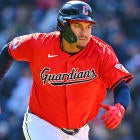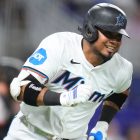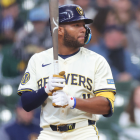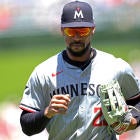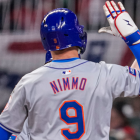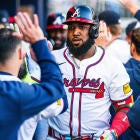Doug Brocail knew why I was calling.
"Willie Blair," he said.
Yes. Willie Blair.
Sixteen years later, J.A. Happ gets hit by a line drive and leaves the ballpark in an ambulance. Sixteen years later, Brocail was thinking what I was thinking.
| More on Happ |
| Related links |
| More MLB coverage |
|
If you've ever been there, and you've ever heard that sound, that awful sound, you don't forget it.
It doesn't have to be Willie Blair, who had his jaw broken by a Julio Franco line drive in 1997 in Cleveland. It could be Bryce Florie. It could be Brandon McCarthy. It could be Chris Young.
If you've been there, if you've heard it, if you've felt it, it stays with you.
"I thought Willie was dead," Brocail said Wednesday.
Fortunately, Willie wasn't dead. Doctors told him that had the ball hit a fraction of an inch from where it did, he could have died, but fortunately it didn't.
Amazingly, he was back on a major-league mound less than a month later. He spent four more years in the big leagues and is now the bullpen coach with the Padres.
Fortunately, Happ survived when he was hit by a Desmond Jennings line drive Tuesday night in a game at Tampa Bay. Fortunately, Happ was released from the hospital by midday Wednesday.
Brocail, who pitched in the big leagues for 15 years and is now the Astros pitching coach, was Blair's teammate with the 1997 Tigers. He knows Happ from Happ's time with the Astros.
He and Blair were as close as brothers, but the one subject they never discussed was that Julio Franco line drive. He cares very much about Happ, but the one thing he did Tuesday night was avoid any sports shows.
"I just did not want to see it," Brocail said.
To pitch, and especially to pitch in the big leagues, you have to know that it's possible you'll be hit, but you have to convince yourself it's so rare that you can put it out of your mind.
Brocail knows he wasn't always able to. Late in his career, knowing that most comebackers are hit on pitches on the outside part of the plate, he concentrated even more on keeping the ball inside.
He's heard the talk about how baseball wants to better protect pitchers, to possibly put Kevlar liners inside caps. He's not opposed, but he also knows it won't take away the risk. It wouldn't have saved Blair's jaw, and may not have helped Happ, either.
"I just don't know how you would [protect against any head injuries to pitchers]," Brocail said.
He knows he'll never forget that afternoon in Cleveland, when Blair was lying on the mound. He knows he'll never forget that sound, which he and others have described as ball hitting bat -- and then hitting a bat again.
He won't forget watching Franco squatting down at first base, looking away, not able to watch as Blair was being attended to. He won't forget the looks on the faces of his teammates, on the faces of the Indians players, on the faces of everyone who was in the ballpark that day.
Watching on television Tuesday night, I saw those faces again, saw them on the Blue Jays and the Rays, on the fans at Tropicana Field.
They won't forget. They'll remember the sound. They'll remember the feeling.
Sixteen years from now, it still won't go away.













